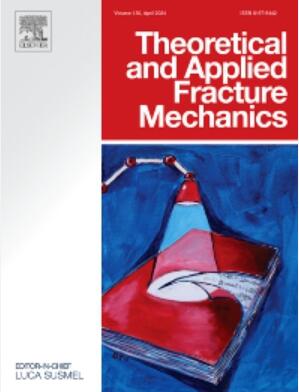钢桥接缝多裂缝扩展特征研究
IF 5
2区 工程技术
Q1 ENGINEERING, MECHANICAL
引用次数: 0
摘要
本研究探讨了钢桥接缝中多重裂纹扩展的形态变化和相互作用机制。通过疲劳试验确定了多条裂纹的起始位置,并获得了易于辨别裂纹扩展轨迹的疲劳断裂面。基于断裂力学理论,使用 ABAQUS 和 FRANC3D 接头模拟技术模拟了接头中共面裂纹和平面外裂纹的扩展行为。分析了形态变化的特征,并研究了不同裂纹间距之间的相互作用机理,从而定量描述了裂纹增强或抑制的相对位置。结果表明,共面裂纹在不同的扩展阶段表现出不同的形态趋势和扩展速率。裂纹前沿的形状不断变化,融合过程中出现的合并点迅速扩大并演变成半椭圆形裂纹。疲劳寿命对多条裂纹的相对位置更为敏感。其中,共面裂纹的融合大大降低了疲劳寿命,而异质裂纹之间的相互抑制效应则提高了疲劳寿命。当共面裂纹间距与裂纹长度之比(s/2c)小于 0.2 时,裂纹融合过程明显加快。此外,当裂纹扩展深度的 a2/a1 比降至 0.5 以下时,抑制效果显著。最后,通过确定多条裂纹之间的间距,本研究建立的方法可为抗疲劳设计和接头优化提供参考。本文章由计算机程序翻译,如有差异,请以英文原文为准。
Research on the propagation characteristics of multiple cracks in steel bridge joints
This study explores the morphological changes and interaction mechanisms of multiple crack propagations in steel bridge joints. Fatigue testing was conducted to determine the locations at which multiple cracks initiated and to obtain fatigue fracture surfaces with easily discernible crack propagation traces. Based on the theory of fracture mechanics, the propagation behavior of coplanar and out-of-plane cracks in joints was simulated using ABAQUS and FRANC3D joint simulation technology. The characteristics of the morphological changes were analyzed, and the interaction mechanism between different crack spacings was investigated to quantitatively characterize the relative positions at which cracks were enhanced or suppressed. The results showed that coplanar cracks exhibited different morphological trends and propagation rates in different stages of propagation. The shape of the crack front continuously changed, and the merging point that appeared during fusion rapidly expanded and evolved into a semi-elliptical crack. The fatigue life was more sensitive to the relative position of multiple cracks. In particular, the fusion of coplanar cracks significantly reduced the fatigue life, and the mutual suppression effect between heterogeneous cracks increased the fatigue life. When the ratio of coplanar crack spacing to crack length (s/2c) was less than 0.2, the crack fusion process significantly accelerated. In addition, when the a2/a1 ratio of the crack propagation depth dropped below 0.5, the suppression effect was significant. Finally, by determining the spacing between multiple cracks, the method established this study can provide a reference for the design of fatigue resistance and joint optimization.
求助全文
通过发布文献求助,成功后即可免费获取论文全文。
去求助
来源期刊

Theoretical and Applied Fracture Mechanics
工程技术-工程:机械
CiteScore
8.40
自引率
18.90%
发文量
435
审稿时长
37 days
期刊介绍:
Theoretical and Applied Fracture Mechanics'' aims & scopes have been re-designed to cover both the theoretical, applied, and numerical aspects associated with those cracking related phenomena taking place, at a micro-, meso-, and macroscopic level, in materials/components/structures of any kind.
The journal aims to cover the cracking/mechanical behaviour of materials/components/structures in those situations involving both time-independent and time-dependent system of external forces/moments (such as, for instance, quasi-static, impulsive, impact, blasting, creep, contact, and fatigue loading). Since, under the above circumstances, the mechanical behaviour of cracked materials/components/structures is also affected by the environmental conditions, the journal would consider also those theoretical/experimental research works investigating the effect of external variables such as, for instance, the effect of corrosive environments as well as of high/low-temperature.
 求助内容:
求助内容: 应助结果提醒方式:
应助结果提醒方式:


